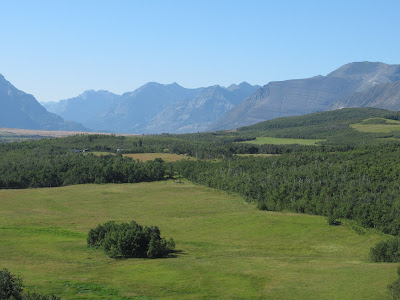I depended on the sky, which seemed to have become even more blue, to have dialed up the colour, if that is possible. It's impossible to imagine infinity. The fact that I want to ask the question "What's beyond the universe?" illustrates the limits of my imagination. But if I study the prairie sky, just stand there and let my eyes sink into it, I feel as if I'm on the edge of understanding infinity. It's like a Mark Rothko or Agnes Martin canvas in that way, thin layers of colour that, where they are thinnest, gesture toward something beyond the canvas. I've also noticed that the light has changed, that late afternoon, early evening, the sun's rays are high in the trees, painting them golden. The light has changed with the solstice. I feel churlish when I say that's not enough.
Early in March, I wrote about my post-Covid mental health struggles (off the menu for today) and about Dacher Keltner's research on awe. Brief recap: he and his team elicited 2,600 brief narratives or descriptions of moments that prompted his subjecs to feel awe. They wrote to Keltner's team in 20 different languages, which, by necessity, means that he sought out at least twenty different perspectives. With this methodology, he sought to eliminate cultural biases. For example, if he'd studied 2,600 Finns, purportedly the happiest people in the world, his sample would have been seriously skewed. Once these descriptions were translated, he and his team sought to identify the kinds of things that elicited awe.
Now I know that when I put a link to a new post on Facebook, it languishes without a photograph. So last night I roamed through my camera looking for my photographs from our visit to Yellowstone, hoping to find a nice big waterfall. I found a modest waterfall from Waterton Park, though the uplift of angled rock hints at awe-inspiring force . Awe is often thought of as vast: Keltner writes "Vastness can be physical--for example, when you stand next to a 350-foot tree or hear a singer's voice or electric guitar fill the space of an arena. Vastness can be temporal, as when a laugh or a scent transports you back in time to the sounds or aromas of your childhood. Vastness can be semantic, or about ideas, most notably when an epiphany integrates scattered beliefs and unknowns into a coherent thesis about the world. Vastness can be challenging, unsettling, and destabilizing. In evoking awe, it reveals that our current knowledge is not up to the task of making sense of what we have encountered. And so, in awe, we go in search of new forms of understanding."
These kinds of vastness seem in accord with my mantra: "Just be curious." You trip over a memory, or the hair on the back of your neck rises in response to music or your heart leaps in joy, and your response is to want to stop and investigate your reaction. Or you want to wrap it around you like a cloak. You don't fully understand it, but there it is, surprising and comforting at the same time.
When Keltner and his team started to create their taxonomy of awe, there were some surprises. Most commonly, awe was inspired by "moral beauty," a phrase I love, a phrase implying an aesthetic different from the one that frequently catches our eye. Moral beauty is not the reason we post selfies to Facebook or Instagram. Experiencing moral beauty, we're moved by someone's kindness, by the "goodness of intention and action." We're moved when people encounter suffering and find surprising strength within themselves. We find moral beauty in the Dalai Lama's smile because the expression on his face manifests his philosophical cheerfulness, his empathy and compassion. We saw it in Nelson Mandela's face because he refused to seek revenge for his years of imprisonment. It is heartening--is that the word I want?--hopeful?--is that the word?--that most of the awe we encounter or feel is prompted by humans at their best. It suggests that some standard--even in an age of wars of aggression and political divisions that make communication all but impossible between people of different beliefs--something still holds.
The next most common experience of awe is encountered in "collective effervescence." That's an expression of sociologist Emile Durkheim. Translated into less abstract words, collective effervescence refers to human bodies in the throes of celebrating their physical prowess--together--in a display of communal effort. You see it in a well-played baseball game and in a ballet. You see it in flash mobs.
I rediscovered flash mobs when my physiotherapist asked me to practice my balance exercises while watching something. Basically, he wants me to distract myself, making it harder to balance and thus teaching my brain some new skills. My ears (my vestibular systems, actually) will never give me reliable information about where horizontal and vertical are, so my brain has to mediate the conflicting information they do give me. I rarely cruise the internet for something to watch, but something about my physiotherapist's directive and my thoughts about "collective effervescence" and the fact videos of flash mobs are around 5 minutes long--about how long it takes me to stand on one foot or pretend I'm on a tight rope--made it a natural. People seeming to gather casually in Prestwick Airport performed ABBA tunes for a woman who is heading out for a birthday vacation. ABBA tunes are lively--in fact any music chosen for a flash mob is likely to have energy, so I kind of bopped along while standing on one foot. I'm afraid Covid-19 made flash mobs rare as hen's teeth, but they're one of my favourite forms of collective effervescence, because they're generous. I particularly like the ones that film the reaction of the audience because their faces light up with surprise and joy, which we see too rarely.
There's one in particular that moved me deeply. A tall string bass player in white tie and tails standing in the middle of a European square begins playing the early notes of Beethoven's "Ode to Joy." He is joined by a cellist, and then two violins come out of nowhere as a crowd collects. Woodwinds come around the corner of one building, brass around another, assembling an orchestra out of nothing. Out of the gathering crowd come more violins and violas. An observer dressed in khakis and a plaid shirt turns out to be a conductor and the crowd to his right, which includes a father with his daughter sitting on his shoulder, begins to sing.
Why would an orchestra do this? What motivated them to rearrange and condense Beethoven's music for a smaller group of musicians playing in a town square? Then they would have had to think through the logistics, all to play the "Ode to Joy" to a crowd that really might not care. Except I'm sure they knew that Beethoven's music is irresistible, even to a little boy in a red shirt who climbed a light pole to direct his very own orchestra. There is moral beauty here, as well as collective effervescence, for they planned this performance simply to bring joy. What human being doesn't need a hit of joy occasionally? It may be part of the human condition, to have a shallow well of joy, especially when spring is in hiding. And music--another source of the awe Keltner found in his 2,600 stories--can bring this to us, especially when it's a cheerful surprise.
So this group of musicians hit three of Keltner's eight sources of awe: moral beauty, collective effervescence, and music. I wish our spring could learn something from flash mobs--nature is another of Keltner's sources of awe. Now I must admit that I began writing this in the middle of April--a dratted ugly April if ever there was one, full of cloudy skies and wind. I couldn't, to be frank, find the energy. It's not kind to dis mother nature, but there it is. She could have done a better job, though maybe she's pissed about how we treat her--and who can argue with that? Finally the windy days seemed to pass, the blue calm to reign in the sky. I've noticed that my Lemony Lace Elderberry, which will be a bright yellowy green, has reddish buds. Who understand the colours of leaves at the beginning of their lives and at the end? My rhubarb is tasting the air with red shoots. The evening darkness is staved off until after 8. Maybe spring is inevitable. Surely warmth and buds and green will eclipse our brown grey world, dropping crystalline petals into the swirling cones of the ferns. I won't have to look quite so hard for my daily awe. It will be right outside my door and I will be thankful.


It's still pretty cold out here -- I'm dressing warmly for a walk I'll take right away -- but the birds are back! Joy joy joy.
ReplyDeleteMy husband is fighting beaver dams down the road; no joy there but gee those creatures are determined.
Warm weather and ease are coming our way, Kathleen. Gotta!
-Kate
Hang onto that hope, Kate! It was almost too warm today in Regina.
ReplyDelete